|
|
|
Sort Order |
|
|
|
Items / Page
|
|
|
|
|
|
|
| Srl | Item |
| 1 |
ID:
132807
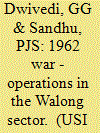

|
|
|
|
|
| Publication |
2014.
|
| Summary/Abstract |
While the Chinese main offensive in the Eastern Theatre was directed against the Tawang - Bomdi La Sector, the subsidiary was launched in the Walong Sector. The Chinese aim was to annihilate the Indian troops deployed in Walong Sector and in the process advance upto their claim line of 07 Nov 1959, i.e. almost the foothills. Initially on the Indian side, Walong Sector was the responsibility of 5 Infantry Brigade which was part of 4 Infantry Division. It was the Assam Rifles which manned the border posts. In response to occasional Chinese incursions through the Lohit Valley, 2 RAJPUT was moved into the area. In Mar 1962, it was replaced by 6 KUMAON.'
|
|
|
|
|
|
|
|
|
|
|
|
|
|
|
|
| 2 |
ID:
124700
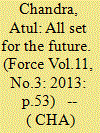

|
|
|
|
|
| Publication |
2013.
|
| Summary/Abstract |
The EADS Innovation Works site at Bangalore exists to prepare the future and explore the synergies for the group and is working on several important projects at present. Interacting with select media in Bangalore on his first visit to India after taking charge as Head of EADS Innovation Works in June this year, Sébastien Remy outlined his plans for the Bangalore centre, "We are focussing on the long term activities like the emerging technologies and solutions". He adds that the Bangalore centre is "working with Cassidian India to optimise performance of radars something that could be fully applicable to existing products. This on-going research work has resulted in the filing of a patent."
|
|
|
|
|
|
|
|
|
|
|
|
|
|
|
|
| 3 |
ID:
125963
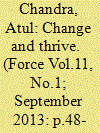

|
|
|
|
|
| Publication |
2013.
|
| Summary/Abstract |
According to Airbus Military over the next three decades, 'the increasing air transport demands will generate the need for some 2,400 multi-role airlifters, with approximately 1,250 of these in the light/medium category'.
India's requirements alone could account for approximately 10 per cent of that market over the next 10 years. The Indian Air Force (IAF) plans to increase its tonnage carrying capacity from 500 tonnes to 1,500 tonnes by 2022. The IAF is fully committed to supporting the Indian Army in the air maintenance task, its Fixed Wing assets carrying in excess of 25,000 tonnes annually. This capacity will be enhanced with the arrival of upgraded and new aircraft with higher payloads and enhanced avionics for higher sortie generation rates
|
|
|
|
|
|
|
|
|
|
|
|
|
|
|
|
| 4 |
ID:
133671
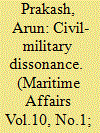

|
|
|
|
|
| Publication |
2014.
|
| Summary/Abstract |
The civil-military equation has been assigned great significance in the national security matrix, and experts consider that nations that fail to evolve a stable paradigm of civil-military relations squander their resources and run grave security risks. In India, this issue has failed to receive the importance it deserves because of the general indifference of the politicians to national security affairs on one hand, and the vested interest of the bureaucracy in maintaining the status quo on the other. It is believed that civil-military relations constitute a zero-sum game in which "civilian control" is retained by reducing the power of the military vis-à-vis the civilians. An irrational but subliminal fear of the military has led the Indian politicians to skew the civil-military equation in favour of the bureaucracy and, in a paradigm unique to India, to place the military under their control. Pointing to the military's sense of grievance and the vitiated atmosphere that prevails in the Ministry of Defence, the author reflects on the price being paid by the nation for endemic "civil-military dissonance" in terms of major national-security shortcomings, as well as the damage being inflicted on the institution of our armed forces.
|
|
|
|
|
|
|
|
|
|
|
|
|
|
|
|
| 5 |
ID:
130089
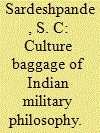

|
|
|
|
|
| Publication |
2014.
|
| Summary/Abstract |
The Gandhi an philosophy at ahimsa has attested the Indian attitude towards war and use of force. Nehruvian distrust ot India's armed forces and military leadership has coloured the dispensation national defence and the armed forces get. Historical, intellectual, cultural and administrative neglect oi the need for national defence cause deep concern. The people and their elected representatives have indifference to and inadequate knowledge of defence matters, their imperatives, demands and consequences. Bhutto said, "We will eat grass, but produce an atomic weapon". This awareness and determination does not sink in our Indian thought. Indian attitude resonates to its cultural ethos - waiting tor something to happen, somewhere, somehow, some time and somebody to take care, without designing things.
|
|
|
|
|
|
|
|
|
|
|
|
|
|
|
|
| 6 |
ID:
126216
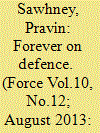

|
|
|
|
|
| Publication |
2013.
|
| Summary/Abstract |
It was a masterstroke by the Pakistan Army 10 years ago. The cue, probably, came from the blockbuster Bollywood movie, Baazigar (gambler), where the hero believed that to gain something big, you have to lose something. By offering the ceasefire on the Line of Control (LC) on 24 November 2003, the Pakistan Army gained a windfall in return for peanuts: it sacrificed covering fire to infiltration across the LC. In return, it got a tamed Indian Army which fenced itself on the LC sending the unambiguous signal that its offensive thinking of the Nineties had been put aside. Docility became the mind-set of the Indian Army and all that is wrong with this wonderful organisation today followed.
|
|
|
|
|
|
|
|
|
|
|
|
|
|
|
|
| 7 |
ID:
131033
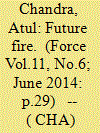

|
|
|
|
|
| Publication |
2014.
|
| Summary/Abstract |
The dismal scenario regarding procurement of artillery guns across various calibres is likely to finally come to an end if the matter is taken up seriously by the new powers that be. If procurements are fast tracked, then it is still a possibility that induction of long range guns and rockets as per the roadmap for Artillery Profile 2027, can be achieved. This would be quite an achievement as trials for 155 mm artillery guns required by the Indian Army began in 2002.
The proposal for the induction of five main types of heavy calibre artillery guns has been stalled for some time now. The Indian Army requires 155mm/52 calibre artillery guns in the following categories: towed gun system, wheeled and tracked self-propelled system and Mounted Gun System (MGS). Of crucial importance in high-altitude areas is the requirement for 145 BAE systems M777 155mm/39 Calibre Ultra-Light Howitzers (ULH), to be acquired through the foreign military sale route from the US. Of these, the M777 is likely to go through first.
Also, to be acquired were indigenously developed systems like the Dhanush 155/45 mm calibre gun and upgraded 130 mm guns. As of 2012, nine regiments had already been equipped with upgraded 130 mm guns. The Ordinance Factory Board (OFB) continues to develop and test the Dhanush 155/45 mm calibre gun. So far, 114 pieces are on order and deliveries for the Dhanush are expected to be completed in the 2018-2020 timeframe. The Request For Proposal (RFP) for upgradation of existing 155 mm/39 calibre FH 77B Bofors to 155 mm/45 Calibre Gun was issued in August 2008.
|
|
|
|
|
|
|
|
|
|
|
|
|
|
|
|
| 8 |
ID:
133012
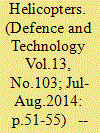

|
|
|
|
|
| Publication |
2014.
|
| Summary/Abstract |
While the Indian military grapples with the complexity of its helicopters procurement process even where the contenders are known and have been around quite some years quietly imperceptibly the helicopter as it is evolving could go to the way of the dodo! Here's a look at the future shape of helicopter.
|
|
|
|
|
|
|
|
|
|
|
|
|
|
|
|
| 9 |
ID:
133009
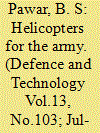

|
|
|
|
|
| Publication |
2014.
|
| Summary/Abstract |
The Aviation Corps ( AAC ) is nowhere near the one envisaged in 1963 by the then COAS Gen jN Chaudhry or as has been projected in the army's perspective plans over the years and lacks some vital elements in its inventory, related to firepower, lift and logistics capability. lt is indeed a far cry from the Aviation Corps of the other professional armies in the world like US and UK and our neighbors China and Pakistan, who operate and own all types of helicopters as well certain number of fixed wing aircraft.
|
|
|
|
|
|
|
|
|
|
|
|
|
|
|
|
| 10 |
ID:
133497


|
|
|
|
|
| Publication |
2014.
|
| Summary/Abstract |
With the new government's emphasis on the defence modernisation, Indian Army's long awaited procurements like Tactical Communication Systems (TCS) and Battlefield Management System (BMS) could see light of the day very soon. Although the focus so far has been on the weapon platforms, the new government must soon realise that communication systems have been lagging far behind. Better Command, Control, Communications, Computers, Intelligence, Surveillance and Reconnaissance systems (C4I2SR) are the need of the hour for the armed forces, especially the Indian Army.
|
|
|
|
|
|
|
|
|
|
|
|
|
|
|
|
| 11 |
ID:
124676
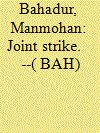

|
|
|
| 12 |
ID:
132809
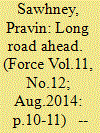

|
|
|
|
|
| Publication |
2014.
|
| Summary/Abstract |
General Bikram Singh took over as the chief of army staff (COAS) on May 31 under extraordinary circumstances. His predecessor, General V.K. Singh took exceedingly much from the army as its chief than he gave back to it. He publicly pitted the army against the government and took the latter to court on the issue of his age for which he alone was responsible. More than blaming a few senior officers for wrongdoings, he floated the impression that most of the officer class had gone to the pits. Towards the fag end of his tenure, he informed the nation that the army lagged behind in terms of modernisation, something he should have done at the beginning of his innings. He gave so many insinuating media interviews that he sounded like a stuck record. While certainly an upright officer, he used the institution to exhaustion. So much so, that it would be long before the army recovers enough to look normal.
|
|
|
|
|
|
|
|
|
|
|
|
|
|
|
|
| 13 |
ID:
124699
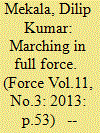

|
|
|
|
|
| Publication |
2013.
|
| Summary/Abstract |
On October 24, Indo-Tibetan Border Police (ITBP) celebrated its 52nd anniversary with a ceremonial parade at the Tigri campus, New Delhi. Looking back at the past year, ITBP can't seem to deny that this has been the most challenging year for their personnel. Starting with the incursions of the Chinese Army at the Line of Actual Control (LAC) in April, which led to the face-off between the Chinese and the Indian forces at the border, to the Uttarakhand flood rescue efforts, considered the biggest ever operation till date, the ITBP faced tough challenges this year. This was again followed by more incursions from the Chinese Army in the subsequent months.
But the good news is that the ITBP is getting a major push from the government to develop its infrastrusture both at the border and its various headquarters in the mainland. Speaking at the Raising Day parade, chief guest R.P.N. Singh, minister of state (Home) said that the government has sanctioned Rs 1,260 crore for construction on the ITBP locations. It includes accommodation for jawans, construction of forward locations and other operational and administrative buildings and structures. He also said that measuring eco-friendly stride towards energy requirement, a total of 69 forward ITBP posts would soon have three to 10 KVA solar power plants which will facilitate uninterrupted power supply for various needs.
|
|
|
|
|
|
|
|
|
|
|
|
|
|
|
|
| 14 |
ID:
126120
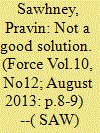

|
|
|
|
|
| Publication |
2013.
|
| Summary/Abstract |
The Cabinet Committee on Security (CCS) has cleared the formation of an army strike corps, a few independent formations including an artillery division for mountains (about 50,000 troops) and certain air force assets ( for airlift). According to reports, the raisings will be done over the next five to seven years at a cost of over Rs 80,000 crores in Panagarh in West Bengal. Meant for Arunachal Pradesh against China, these forces will have their permanent locations in the states of Odisha, Chhattisgarh, Jharkhand and West Bengal.
|
|
|
|
|
|
|
|
|
|
|
|
|
|
|
|
| 15 |
ID:
132798
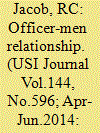

|
|
|
|
|
| Publication |
2014.
|
| Summary/Abstract |
A soldier is an epitome of valour and courage. He does his duty under unforeseen circumstances, even under incomprehensible odds, which sometimes lead to grave injuries and loss of life. Simultaneously, an officer in the Armed Forces is a dedicated professional leader who has to lead by example. Together they
fight for their country and unreservedly perform the tasks assigned to them both, in peace and war.
|
|
|
|
|
|
|
|
|
|
|
|
|
|
|
|
| 16 |
ID:
131046
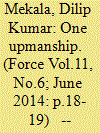

|
|
|
|
|
| Publication |
2014.
|
| Summary/Abstract |
Ever since the border face-off between Indian and Chinese Troops in the Depsang Bulge at the Line of Actual Control (LAC) in April 2013, the Indian Army has raised its pitch to acquire Operational Control of the Indo-Tibetan Border Police Force (ITBP). But that one incident couldn't have been the trigger, and it's not correct to dismiss ITBP's role in handling the situation. After all, the ITBP had followed all international protocols which ultimately led to the solution through diplomatic channels.
The Indian Army cannot be deployed along the forward posts at the LAC according to various UN conventions. So naturally when the Chinese troops entered the Indian territory close to the Burtse post in the Depsang Bulge, the ITBP was the first respondent. According to a source privy to the information, when the Chinese patrol team was observed coming close to the Burtse post, roughly around one-and-a-half or two kilometres away, the ITBP teams responded immediately. As per the Standard Operating Procedures (SOP), the ITBP has to inform all the stakeholders in events such as this. Sources claimed that the information was indeed relayed to all the stakeholders like National Security Advisor (NSA), defence ministry, Indian Army and various intelligence agencies in real time. The ITBP boasts of its quick communication to as many as 11 agencies involved in resolving the stand-off.
|
|
|
|
|
|
|
|
|
|
|
|
|
|
|
|
| 17 |
ID:
133672
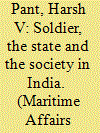

|
|
|
|
|
| Publication |
2014.
|
| Summary/Abstract |
These are difficult times for civil-military relations in India. They may appear normal superficially but lurking beneath the surface are serious differences. "More than ever the balance between the Indian state, the Indian society and the nation's military institutions is out of kilter. This can have grave implications if the equilibrium is not promptly restored because only nations which are successful in evolving a properly balanced pattern of civil-military relations succeed in their search for security while those who fail, merely end up squandering their limited resources and put their national security at risk". While the Indian State cannot absolve itself of the way it has handled the nation's military, Indian military also needs to do some serious introspection. "Blaming the government for all the ills afflicting the defence sector seems to be becoming the default position within the ranks of the military and taking this too far can be really dangerous for the liberal democratic ethos of this nation".
|
|
|
|
|
|
|
|
|
|
|
|
|
|
|
|
| 18 |
ID:
132806
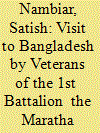

|
|
|
|
|
| Publication |
2014.
|
| Summary/Abstract |
The idea of such a visit has its origins in a brief exchange between Lieutenant Generals Satish Nambiar (Y Company Commander during the 1971 War) and YM Bammi (GSO-2 in 101 Communication Zone Area) when the latter (who was nominated for travel to Bangladesh as part of the yearly Adjutant General's Branch sponsored visit in mid-December 2013) wished to obtain some photographs of the Jangi Paltan's actions. He was referred to Lieutenant Colonel KS Puntambekar (C Company Commander during the War). This reference by YM Bammi, and the fact that he was able to establish contact with Zohal Haq Munshi (the freedom fighter who, together with many others, was with the Paltan from prior to the War right through to the entry into Dhaka on the afternoon of 16"' December 1971), spurred Keshav
Puntambekar into action in his own inimitable style. In mid-January 2014, he got in touch with Lieutenant General KS Brar (who was the Commanding Officer of the Jangi Paltan during the war) and a number of other colleagues suggesting that we travel together as a group to Bangladesh to revisit the sites where the Jangi Paltan fought memorable battle actions during the War of Liberation in 1971.
|
|
|
|
|
|
|
|
|
|
|
|
|
|
|
|
| 19 |
ID:
132257
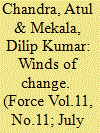

|
|
|
|
|
| Publication |
2014.
|
| Summary/Abstract |
Ensuring that delayed crucial aviation projects are delivered fast should be the new government's priority
Hope is riding high on the new Narendra Modi government. Little over a month after assuming the high office, India's Prime Minister has managed to boost the confidence of the Indian military forces. While symbolic gestures like spending a day aboard INS Vikramaditya helped to bring in motivation to the Indian Navy, which was plagued by series of accidents in the last few months; it is his policy decisions like opening up the defence industry to the private sector that has attracted foreign investors' confidence.
|
|
|
|
|
|
|
|
|
|
|
|
|
|
|
|
|
|
|
|
|